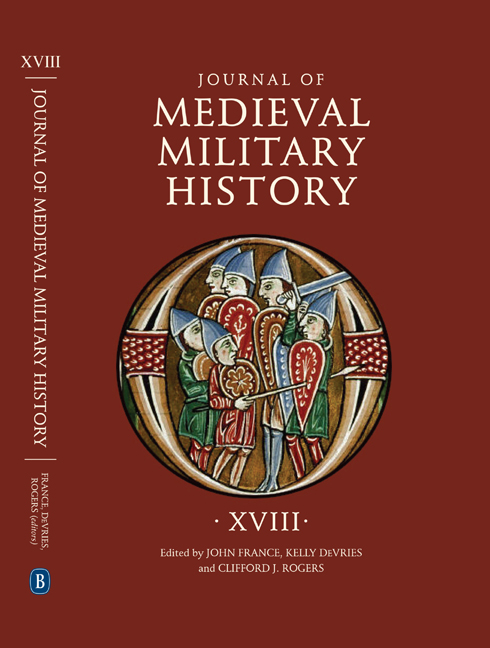Book contents
- Frontmatter
- Contents
- List of Illustrations
- 1 The Eastern Campaigns of King Henry II of Germany, 1003–17
- 2 Peace, Popular Empowerment and the First Crusade
- 3 The Transformation of Naval Warfare in Scandinavia during the Twelfth Century
- 4 Auxiliary Peoples and Military Reform on Hungary’s Western Frontier in the Thirteenth Century
- 5 What Types of Sources Did Medieval Chroniclers Use to Narrate Battles? (England and France, Twelfth to Fifteenth Centuries)
- 6 Experimental Tests of Arrows against Mail and Padding
- 7 Four Misunderstood Gunpowder Recipes of the Fourteenth Century
- 8 The Earliest Middle English Recipes for Gunpowder
- 9 Horses and Horsemen in Fifteenth-Century Siege Warfare, with Particular Reference to the Later Hundred Years War
- 10 Supplying the Army: The Siege of Pisa, 1499
- List of Contributors
- Journal of Medieval Military History 1477–545X
7 - Four Misunderstood Gunpowder Recipes of the Fourteenth Century
Published online by Cambridge University Press: 06 October 2020
- Frontmatter
- Contents
- List of Illustrations
- 1 The Eastern Campaigns of King Henry II of Germany, 1003–17
- 2 Peace, Popular Empowerment and the First Crusade
- 3 The Transformation of Naval Warfare in Scandinavia during the Twelfth Century
- 4 Auxiliary Peoples and Military Reform on Hungary’s Western Frontier in the Thirteenth Century
- 5 What Types of Sources Did Medieval Chroniclers Use to Narrate Battles? (England and France, Twelfth to Fifteenth Centuries)
- 6 Experimental Tests of Arrows against Mail and Padding
- 7 Four Misunderstood Gunpowder Recipes of the Fourteenth Century
- 8 The Earliest Middle English Recipes for Gunpowder
- 9 Horses and Horsemen in Fifteenth-Century Siege Warfare, with Particular Reference to the Later Hundred Years War
- 10 Supplying the Army: The Siege of Pisa, 1499
- List of Contributors
- Journal of Medieval Military History 1477–545X
Summary
There are only a few known gunpowder recipes securely datable to fourteenth- century Europe. All of them have been published, but most of the texts have been misread, misprinted, or misunderstood. This article offers a corrected transcription and translation of the group of three recipes in the Breviarium Bartholomei of John of Mirfield (c.1380–95), and sets it in the context of other late-fourteenth to early-fifteenth century recipes.
Few technological innovations have been as momentous as the development of gunpowder. Gunpowder was the first major harnessing of chemical energy by humans since the mastery of fire, and the development of gunpowder artillery has been commonly used since the eighteenth century as the original and archetypical example of a “military revolution.” Whether cannon actually did “revolutionize” warfare is a debated subject, but most of those who argue that it did do so date the Artillery Revolution to some time in the first half of the fifteenth century. By then, however, gunpowder artillery had been in use for around a century. Our sources allow us a reasonably good understanding of the development of guns during the fifteenth century, but our information about the fourteenth century (especially in the first fifty years, from c.1326 to c.1375) is relatively thin.
The same is true of the development of gunpowder. All gunpowder includes a mix of saltpeter, sulfur, and charcoal. Nineteenth-century gunpowder was typically mixed with ratios of around 75:10:15 (in that order), i.e. with a saltpeter:sulfur ratio of 7.5:1 and a saltpeter content of 75%. Several early fifteenth-century recipes come fairly close to that mix, though some have significantly more sulfur content. A recipe from Montauban of the turn of the fifteenth century calls for 22:4:5 (71%/13%/16%). One of the two Frankfurter Büchsenmeisterblätter recipes (c.1400) gives a ratio 5:1:1 (71%/14%/14%). The 1405 manuscript of Bellifortis includes a 4:1:0.5 (73%/18%/9%) mix; the Büchsenmeisterbuch (composed at an uncertain date before 1411, probably around 1400) recommends the same mixture with small additions of salarmoniac (ammonium chloride) and salpracticum (a mix of saltpeter and salarmoniac), or 3.5:1:0.5 (70%/20%/10%) without those extra ingredients. Abundant evidence shows a shift towards – or back towards – somewhat lower saltpeter content in later fifteenth-century recipes, including those edited by Trevor Russell Smith in the following article in this volume of the Journal of Medieval Military History.
- Type
- Chapter
- Information
- Journal of Medieval Military HistoryVolume XVIII, pp. 173 - 182Publisher: Boydell & BrewerPrint publication year: 2020

